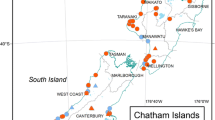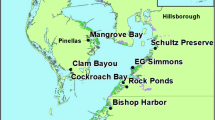Abstract
Wetlands can store large quantities of carbon (C) and are considered key sites for C sequestration. However, the C sequestration potential of wetlands is spatially and temporally variable, and depends on processes associated with C production, preservation and export. In this study, we assess the soil C sources and processes responsible for C sequestration of riverine wetlands (mangroves, peat swamp forest and marsh) of La Encrucijada Biosphere Reserve (LEBR, Mexican south Pacific coast). We analysed soil C and nitrogen (N) concentrations and isotopes (δ13C and δ15N) from cores dated from the last century. We compared a range of mangrove forests in different geomorphological settings (upriver and downriver) and across a gradient from fringe to interior forests. Sources and processes related to C storage differ greatly among riverine wetlands of the Reserve. In the peat swamp forest and marsh, the soil C experienced large changes in the past century, probably due to soil decomposition, changes in plant community composition, and/or changes in C sources. In the mangroves, the dominant process for C accumulation was the burial of in situ production. The C buried in mangroves has changed little in the past 100 years, suggesting that production has been fairly constant and/or that decomposition rates in the soil are slow. Mangrove forests of LEBR, regardless of geomorphological setting, can preserve very uniform soil N and C for a century or more, consistent with efficient C storage.





Similar content being viewed by others
References
Adame MF, Lovelock CE (2011) Carbon and nutrient exchange of mangrove forests with the coastal ocean. Hydrobiol 663:23–50
Adame MF, Neil D, Wright SF, Lovelock CE (2010) Sedimentation within and among mangrove forests along a gradient of geomorphological settings. Estuar Coast Shelf Sci 86:21–30
Adame MF, Fry B, Gamboa JN, Herrera-Silveira JA (2015a) Marine subsidies delivered by seabirds to mangrove islands. Mar Ecol Prog Ser 525:15–24
Adame MF, Santini NS, Tovilla C, Vazquez-Lule A, Castro L (2015b) Carbon stocks and soil sequestration rates of tropical riverine wetlands. Biogeosciences 12:3805–3818
Alongi DM (2008) Mangrove forests: resilence, protection from tsunamis, and responses to global climate change. Estuar Coast Shelf Sci 76:1–13
Alongi DM (2011) Carbon payments for mangrove conservation: ecosystem constraints and uncertainties of sequestration potential. Environ Sci Policy 14:462–470. doi:10.1016/j.envsci.2011.02.004
Bouillon S, Borges AV, Castañeda-Moya E et al (2008) Mangrove production and carbon sinks: a revision of global budget estimates. Global Biogeochem Cycles 22:1–12
Breithaupt JL, Smoak JM, Smith TJ III, Sanders CJ, Hoare A (2012) Organic carbon burial rates in mangrove sediments: Strenghtening the global budget. Glob Biogeochem Cycles 26:GB3011
Delegue MA, Fuhr M, Schwartz D, Mariotti A, Nasi R (2001) Recent origin of a large part of the forest cover in the Gabon coastal area based on stable carbon isotope data. Oecologia 129:106–113
Donato DC, Kauffman JB, Murdiyarso D, Kurnianto S, Stidham M, Kanninen M (2011) Mangroves among the most carbon-rich forests in the tropics. Nat Geosci 4:293–297
Duke NC, Meynecke J-O, Dittmann S et al (2007) A world without mangroves? Science 317:41–42
Ewel KC, Twilley JE, Ong J-E (1998) Different kinds of mangrove forests provide different goods and services. Glob Ecol Biogeogr Lett 7:83–94
Eyre BD (1993) Nutrients in the sediments of a tropical north-eastern Australian estuary, catchment and nearshore coastal zone. Aust J Mar Freshw Res 44:845–866
Fry B (2006) Stable isotope ecology. Springer, New York
Fry B, Cormier N (2011) Chemical ecology of red mangroves, Rhizophora mangle, in the Hawaiian Islands. Pac Sci 65:219–234
Gonneea ME, Paytan A, Herrera-Silveira J (2004) Tracing organic matter sources and carbon burial in mangrove sediments over the past 160 years. Estuar Coast Shelf Sci 61:211–227
Intergovernmental Panel on Climate Change (IPCC) (2007) Fourth assessment report: climate change 2007. http://www.ipcc.ch/publications_and_data/ar4/wg2/en/annexessglossary-a-d.html. Accessed 20 January 2015
Kayranli B, Scholz M, Mustafa A, Hedmark A (2010) Carbon storage and fluxes within freshwater wetlands: a critical review. Wetlands 30:111–124
Kristensen E, Bouillon S, Dittmar T, Marchand C (2008) Organic carbon dynamics in mangrove ecosystems: a review. Aquat Bot 89:201–219
Kurnianto S, Warren M, Talbot J, Kauffman B, Murdiyarso D, Frolking S (2015) Carbon accumulation of tropical peatlands over millennia: a modelling approach. Glob Change Biol 21:431–444
Lovelock CE, Feller IC, Adame MF, Reef R, Penrose H, Wei L, Ball MC (2011) Intense storms and the delivery of materials that relieve nutrient limitations in mangroves of an arid zone estuary. Funct Plant Biol 36:514–522
Mariotti AP, Pierre DTB, Vedy JC, Bruckert SV (1980) The abundance of natural Nitrogen 15 in the organic matter of soils along an altitudinal gradient (Chablais, Haute Savoie, France). Catena 7:293–300
Mckee KL, Feller IC, Popp M, Wanek W (2002) Mangrove isotopic (δ15N AND δ13C) fractionation across a nitrogen vs. phosphorus limitation gradient. Ecology 83:1065–1075
McKee KL, Cahoon DR, Feller IC (2007) Caribbean mangroves adjust to rising sea level through biotic controls on change in soil elevation. Glob Ecol Biogeogr 6:545–556
Mcleod E, Chmura GL, Bouillon S et al (2011) A blueprint for blue carbon: toward an improved understanding of the role of vegetated coastal habitats in sequestering CO2. Front Ecol Environ 9:552–560
Monacci NM, Meier-Grünhagen U, Finney BP, Behling H, Wooller MJ (2011) Paleoecology of mangroves along the Sibun River, Belize. Quat Res 76:220–228. doi:10.1016/j.yqres.2011.06.001
Nadelhoffer KJ, Fry B (1988) Controls on natural nitrogen-15 and carbon-13 abundances in forest soil organic matter. Soil Sci Soc Am J 52:1633–1640
Page S, Rieley JO, Banks C (2011) Global and regional importance of the tropical peatland carbon pool. Glob Change Biol 17:798–818
Perdue EM, Koprivnjak JF (2007) Using the C/N ratio to estimate terrigenous inputs of organic matter to aquatic environments. Estuar Coast Shelf Sci 73:65–72
Saenger P, Snedaker SC (1993) Pantropical trends in mangrove above-ground biomass and annual litterfall. Oecologia 96:293–299
Sistema Meteorológico Nacional Comisión Nacional del Agua, SMN. http://www.conagua.gob.mx/ocgc/. Accessed September 2014
Tamooh F, Huxham M, Karachi M, Mencuccini M, Kairo JC, Kirui B (2008) Below-ground root yield and distribution in natural and replanted mangrove forests at Gazi bay, Kenya. For Ecol Manag 256:1290–1297
Tovilla HC, Salas RLR, de la Presa PJC, Romero EIB, Ovalle EF, Gómez OR (2007) Informe final: Inventario forestal de los bosques de manglar del Soconusco, Gobierno del Estado de Chiapas. Consejo Nacional de Ciencia y Tecnología. El Colegio de La Frontera Sur, Chiapas, México
United Nations Educational, Scientific and Cultural Organization (2013) http://www.unesco.org/mabdb/br/brdir/directory/biores.asp?mode=all&codE588X+23. Accessed March 2013
Williams S, Self S (1983) The October 1902 plinian eruption of Santa Maria Volcano, Guatemala. J Volcanol Geotherm Res 16:33–56
Woodroffe CD (1992) Mangrove sediments and geomorphology. In: Robertson AI, Alongi DM (eds) Coast estuar stud. American Geophysical Union, Washington, p 329
Wooller M, Smallwood B, Jacobson M, Fogel M (2003a) Carbon and nitrogen stable isotopic variation in Laguncularia racemosa (L.) (white mangrove) from Florida and Belize : implications for trophic level studies. Hydrobiologia 499:13–23
Wooller M, Smallwood B, Scharler U, Jacobson M (2003b) A taphonomic study of δ13C and δ15N in Rhizophora mangle leaves for a multi-proxy approach to mangrove palaeoecology. Org Geochem 34:1259–1275
Acknowledgments
We want to thank the Australian Rivers Institute at Griffith University and to the Mexican Fund for the Conservation of Nature (Fondo Mexicano para la Conservación de la Naturaleza (FMCN), A.C.) and the USDA Forest Service. Funding for the study was provided by the US Agency for International Development (USAID /Mexico) as part of a workshop on quantification of wetland carbon stocks. We wish to thank the participants of this workshop for their contributions of data collection in the field. We are grateful for field support to the National Commission for Natural Protected Areas (CONANP), especially to Leonardo Castro, and to Dr. Vanessa Valdez, Juan Manuel Frausto Leyva and Richard Birdsey for logistic support.
Funding sources
This study was funded by the US Agency for International Development (USAID /Mexico) as part of a workshop on quantification of wetland carbon stocks. The funding was administered by the USDA Forest Service and the Mexican Fund for the Conservation of Nature (Fondo Mexicano para la Conservación de la Naturaleza (FMCN), A.C.). Logistical support was provided by the Australian Rivers Institute at Griffith University and the National Mexican Commission for Natural Protected Areas (CONANP).
Author information
Authors and Affiliations
Corresponding author
Rights and permissions
About this article
Cite this article
Adame, M.F., Fry, B. Source and stability of soil carbon in mangrove and freshwater wetlands of the Mexican Pacific coast. Wetlands Ecol Manage 24, 129–137 (2016). https://doi.org/10.1007/s11273-015-9475-6
Received:
Accepted:
Published:
Issue Date:
DOI: https://doi.org/10.1007/s11273-015-9475-6




